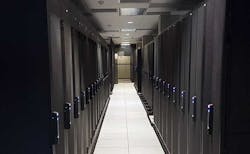Data Center Insights: Adam Compton of Schneider Electric
The Data Center Frontier Executive Roundtable features insights from industry executives with lengthy experience in the data center industry. Here’s a look at the insights from Adam Compton of Schneider Electric
Adam Compton is the Director of Strategy for Schneider Electric, where he leads business strategy for the North American business, focused on IT and data center markets and applications for high available power and cooling solutions. With over 20 years of experience, originally hailing from APC, he is responsible for monitoring and analyzing market intelligence towards the goal of revenue growth for Schneider Electric. As an entrepreneurial leader, Adam attends industry conferences and is a mentor capable of directing large cross-functional teams. He also serves on the Board of Directors for Junior Achievement of Rhode Island and received a Bachelor of Science in English from Tulane University.
Here’s the full text of Adam Compton's insights from our Executive Roundtable:
Data Center Frontier: Recent earnings reports suggest the growth rate of cloud computing has moderated slightly. What’s your take on the progress of cloud computing – the “what inning are we in” question – and what lies ahead?
Adam Compton, Schneider Electric: 3rd Inning, our starting pitcher just gave up a few hits. But we leave the pitcher in the game…
There is a natural ebb and flow to the data center industry, using tides as another analogy. We saw a huge tidal surge in the Covid era ’20-’22. That surge has subsided, and enterprise customers are re-assessing all the benefits of Xaas. The benefit of Opex vs Capex was intoxicating, and was highly encouraged across enterprise and SMB customers. Well now finance teams are looking at their Opex and wondering if IT went too far. I’m sure the question from finance goes something like this “are we really using all of these outsourced IT cloud capabilities you bought into over the past 3 years?”
In addition, like any business model where outsourcing is part of the value proposition, there is a loss of control by the customer. They sacrifice control over their operations for cost/expertise/peace of mind. As there is a reckoning of enterprise/SMB opex expenses in colo/cloud, a part of the equation is whether it’s worth the loss of control.
In addition to customer demand changes, there’s pressure on multi-tenant and cloud data center companies from investors – those investors could be the internal kind whereby a data center business looks at its build-out plan during a time of peak demand and low supply very differently than during a time when the opposite is true. In terms of outside investors, they were skeptical (and maybe even suspicious) of data centers as an industry, as a business for years. The Covid era changed the buildout forecast of a cloud or colo infrastructure company from 6 months visibility to 18-24 months. That’s the kind of projections outside investors like, so funding flowed to build more data centers with long lead times, meaning they put their money down ASAP to reserve stock. Now those outside investors are seeing the enterprise customer pull back, seeing the slowing of the demand, and seeing supply chain improvements and are back to being skeptical (but no longer suspicious).
* Don’t worry, AI will be the wave that makes us forget all about the small tidal undertow we feel now.
Data Center Frontier: How would you assess the state of the data center supply chain? What items continue to experience long lead times or availability problems?
Adam Compton, Schneider Electric:
Supplies have improved for some products to pre-pandemic levels. Expectations for supply have also re-adjusted. The race back to improved timelines has been a boon for customers who can now either return to their preferred brands/solutions, or can play vendors off each other as to who can move quickest to get the prize. Large system metals are still a challenge. Within our business, battery chemistries are under review because of competition for the same materials vs much larger industries. In addition, different and innovative battery chemistries can lead to better outcomes for efficiency, cost, and sustainability.
Data Center Frontier: Data centers have always been highly-automated facilities. What are the most promising opportunities in automation and data center management? Can AI, augmented reality, and robots play a meaningful role?
Adam Compton, Schneider Electric: I like to contemplate whether data centers can become digitized… Aren’t they, by nature, digitized? However, we all appreciate the complicated human network that enables a data center to function. And unlike a factory machine that traditionally may have shown its failure physically with an immediately identifiable poor output from a faulty part/function, the failure of a data center is invisible, and often slow to manifest itself.
So yes, you can digitize a data center, and we love to do it. We have been in the DCIM business since I started in this industry 25 years ago by ensuring there was graceful network shutdown, and the ability to communicate with a UPS’s higher thinking via SNMP. Naturally the sophistication has multiplied in 25 years. Today the value of a data center management tool starts with the design – designing systems that integrate both physically and digitally.
A good DCIM offer allows for Planning & Modeling for the optimization of critical IT infrastructure. And of course, no DCIM product can call itself worthy unless it can Monitor and Manage critical infrastructure. A solution that has been iterating and concentrating solely on the management of the critical infrastructure for >25 years will have what the modern data center operator needs to design, build, operate, and maintain a data center of any size in any location.
The future will include preventative and prescriptive services, and the future is now. The future will also enable a CIO to answer new vital questions like what is the energy efficiency of my data centers, and what is the carbon footprint of my data centers. And that future is also now.
Data Center Frontier: The industry has stepped up its efforts to attract and retain talent, but staffing remains a huge challenge. What’s working well, and what more can be done to build a diverse workforce of the future.
Adam Compton, Schneider Electric: We would and could move faster in the IT industry but for the lack of qualified and motivated engineers starting in the offer/software design phase.
* There is appetite for growth in every business, and across large scale multi-tenant data centers to do more with IT.
* There will be enough operators to keep IT moving, but there will not be enough engineers and operators to advance at the speed of the industry demand.
* Movement towards increasing diversity in the workforce will help. We are not a diverse industry. For instance, the US workforce is 47% women; IT industry today 28% women; STEM engineers 15%, trades low single digits. The work in IT from product design, to programming, to IT & data center operations is interesting, impactful, and intellectually stimulating. As personal and professional life rely more and more on IT infrastructure, there will be enough draw to bring in “some” diverse talent. However, proactive efforts are needed, and effective. Collegiate recruiting is especially fun. One need simply open up the conversation by saying “do you know there’s an entire industry that makes that phone do what it does… and it pays well, and they are hiring.”
About the Author




